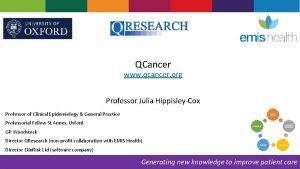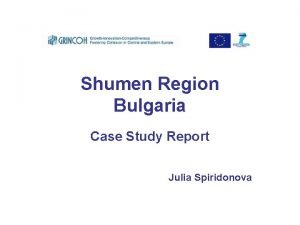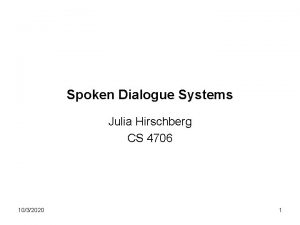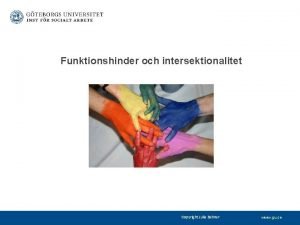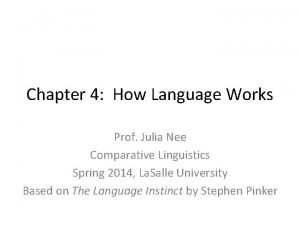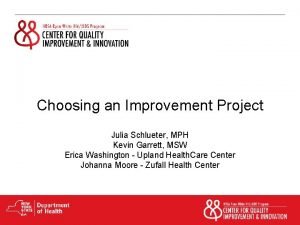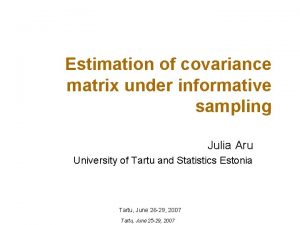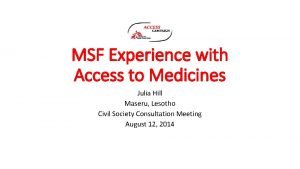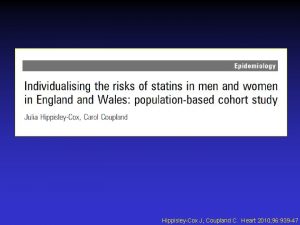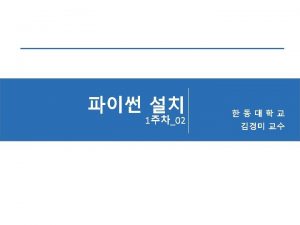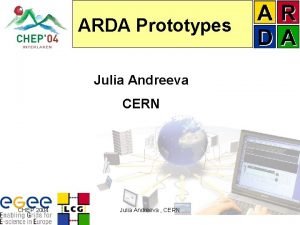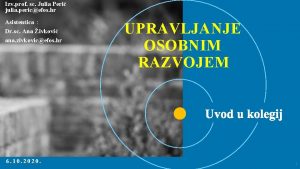QCancer www qcancer org Professor Julia HippisleyCox Professor





















- Slides: 21

QCancer www. qcancer. org Professor Julia Hippisley-Cox Professor of Clinical Epidemiology & General Practice Clinical practice Professorial Fellow St Annes, Oxford Implement Research questions GP Woodstock Director QResearch (non-profit collaboration with EMIS Health) Innovate Research Director Clin. Risk Ltd (software company) Generating new knowledge to improve patient care

v QResearch database founded in 2003 v Collaboration with EMIS Health v One of the largest databases of linked electronic health records internationally v Anonymised data from > 1500 practices v Individual data > 30 million patients v Historical Data > 25 years v World beating resource for innovative medical research v Many tools integrated into EMIS Web ONS mortality Cancer Registry GP Data Hospital data Other data sources Generating new knowledge to improve patient care

Clinical practice Implement Innovate Research questions Undertake Research Generating new knowledge to improve patient care

Risk Prediction Tools • Developed, validated and implemented suite of novel risk prediction tools v. Prognostic models - Risk of future disease v. Diagnostic models - Risk of current disease • 1 st time national GP data used to develop risk tools • Enables informed consent - improved risk communication • Enables risk stratification – targeting resources to highest risk & those most likely to benefit from interventions v. Screening & prevention v. Early diagnosis • Independent, external and international validations undertaken • Recommended in NICE guidelines & implemented into NHS computer systems Generating new knowledge to improve patient care

QTools-absolute risk of major outcomes QCancer - 3 aspect • risk of current cancer • 10 year risk of cancer • prognosis for patients with cancer • • QRISK 3 QStroke QDiabetes QFrailty & QMortality QAdmissions QBleed QDiabetes QKidney Generating new knowledge to improve patient care

Early diagnosis of cancer: The problem • 300, 000 new cancers each year • UK has relatively poor track record when compared with other European countries • Partly due to late diagnosis with estimated 7, 500+ lives lost annually • Later diagnosis due to mixture of • late presentation by patient (lack awareness) • Late recognition by GP • Delays in secondary care • Earlier diagnosis cancer improves chances of survival www. qcancer. org

NICE guidance on suspected cancer • Symptom based approach (2015) • Lower threshold for intervention to 3% PPV of individual cancers • More investigation and referral • Didn’t make explicit reference to use of risk assessment tools • Used research underpinning QCancer to develop guidance • Qcancer provides practical way to identify patients at risk to improve early diagnosis • QCancer now in EMIS Web www. qcancer. org

Why symptoms based approach? • Many patients present with symptoms • GPs need to decide which patients to investigate and refer • Decision support tool must mirror setting where decisions made • Symptoms based approach needed (rather than cancer based) • Must account for multiple symptoms • Must have face clinical validity eg adjust for age, sex, smoking, Family history • Need to be able to update to meet changing requirements, populations, recorded data www. qcancer. org

QCancer– what it needs to do • Accurately predict individual level of risk of multiple cancers for based on multiple risk factors and multiple symptoms • Discriminate between patients with and without cancer • Help guide decision on who to investigate or refer and degree of urgency. • Educational tool for sharing information with patient. Sometimes will be reassurance. • QCancer combined model published BJGP January 2013 • Cancer in women • Cancer in men www. qcancer. org

Methods – development algorithm • Representative cohort from QResearch 2. 5 million men & women aged 25 -89 years • cancer outcome - all new diagnoses on GP record or linked record in 2 years • Identify key risk factors • Identify key symptoms • Established methods to develop risk prediction algorithm • Measure of absolute risk of any cancer as well as by cancer type www. qcancer. org

QCancer predicts global cancer risk & risk 12 types cancers Lung Pancreas Renal tract Ovary • Colorectal Gastro Testis Breast Prostate Blood www. qcancer. org Cervix Uterus • These accounts for 85% cancers Plan to extend to rarer cancers when sufficient data

Key Risk Factors in QCancer Demographics life style www. qcancer. org Co-morbidities Age COPD Sex Endometrial hyperplasia/polyp Smoking status Chronic pancreatitis Alcohol use Type 2 diabetes Deprivation score Anaemia (HB < 11 g/DL) Family history of cancer Venous thromboembolism

Key symptoms in model general Loss of appetite Unintentional weight loss Indigestion +/- heart burn Dysphagia Abdominal pain or swelling Constipation Night sweats Cough Neck lump women Vaginal Bleeding Breast lump Breast pain Nipple changes www. qcancer. org Bleeding Haemoptysis Haematemesis Haematuria Rectal bleeding Haematuria Unexplained bruising Men Genito-Urinary symptoms (men) - Retention - Nocturia - Frequency - Impotence - Testicular lump

Validation of QCancer • Essential to demonstrate the tools work and identify right people in an efficient manner • Tested performance ü separate sample of QResearch practices üexternal dataset (Vision practices) • Good at identifying those who do and don’t have cancer • Good at estimating level of risk • Real world testing 2013 -14 with Macmillan and CRUK to evaluate its use in > 250 practices across the UK. • Currently used in the NHS England ACE program www. qcancer. org Don’t forget QCancer works out cancer risk NOT diagnosis

Using QCancer in practice Standalone web calculator www. qcancer. org Integrated into clinical system • Within consultation: GP with patients with symptoms • Within consultation QOF style alert • Run in batch mode to risk stratify populations www. qcancer. org

QCancer Protocol Alert Ø Alert on all sites now (version 5. 5) Ø Deployed in INACTIVE form Ø Practices need to activate it: Ø https: //www. emisnug. org. uk/activating-qcanceralerts Ø Alert will appear if codes added during consultation on fly e. g. if add haematuria, it will pop up Ø Click on score will take you to template

QCancer symptom checker template • Template to capture relevant symptoms & risk factors • https: //qcancer. org/female/

QCancer site specific scores

QCancer follow up template

QCancer Batch Add • Similar to QRISK 2 which is in 95% of GP practices– automatic calculation of risk for all patients in practice based on existing data. • Safety netting - Identify patients with symptoms/adverse risk profile without follow up/diagnosis • Enables systematic recall or further investigation • Systematic approach - prioritise by level of risk. • https: //www. emisnug. org. uk/batch-add-cancer-riskscore www. qcancer. org

Thank you for listening & any questions Generating new knowledge to improve patient care
 Qcancer
Qcancer Rómeó jellemzése
Rómeó jellemzése Promotion from associate professor to professor
Promotion from associate professor to professor Julia switch case
Julia switch case Aunt julia poem
Aunt julia poem Julia hirschberg
Julia hirschberg La dualidad del ser a julia de burgos
La dualidad del ser a julia de burgos Poema en veinte surcos
Poema en veinte surcos Intersektionalitet
Intersektionalitet Julia belina
Julia belina Aunt julia annotated
Aunt julia annotated How language works
How language works Julia garber
Julia garber Julia schlueter
Julia schlueter Bvacizumab
Bvacizumab Kranah
Kranah Inka westerlund
Inka westerlund Julia covariance matrix
Julia covariance matrix Msf access
Msf access Rwikipedia
Rwikipedia Julia bancroft apartments
Julia bancroft apartments Julia banaszkiewicz
Julia banaszkiewicz
